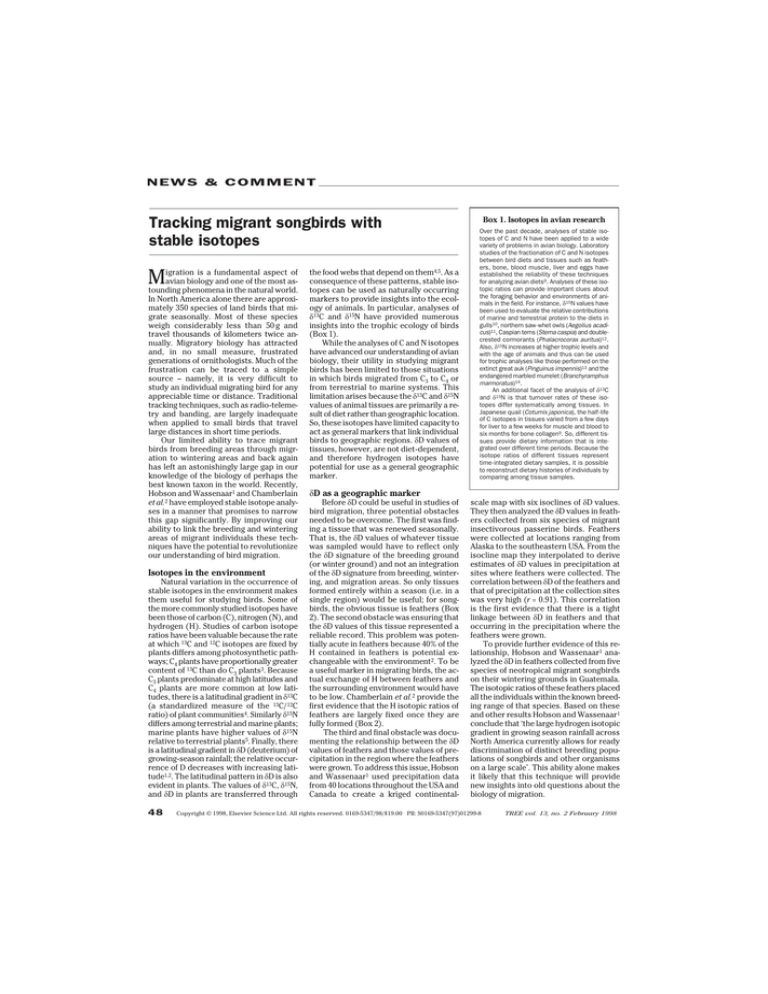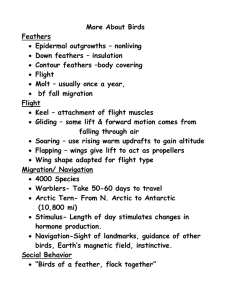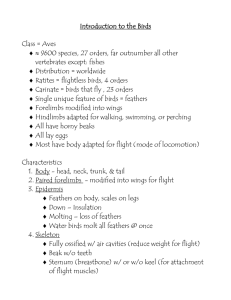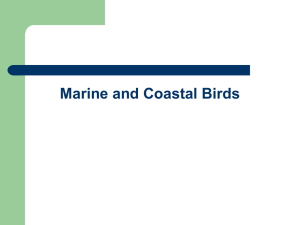
NEWS & COMMENT
Tracking migrant songbirds with
stable isotopes
M
igration is a fundamental aspect of
avian biology and one of the most astounding phenomena in the natural world.
In North America alone there are approximately 350 species of land birds that migrate seasonally. Most of these species
weigh considerably less than 50 g and
travel thousands of kilometers twice annually. Migratory biology has attracted
and, in no small measure, frustrated
generations of ornithologists. Much of the
frustration can be traced to a simple
source – namely, it is very difficult to
study an individual migrating bird for any
appreciable time or distance. Traditional
tracking techniques, such as radio-telemetry and banding, are largely inadequate
when applied to small birds that travel
large distances in short time periods.
Our limited ability to trace migrant
birds from breeding areas through migration to wintering areas and back again
has left an astonishingly large gap in our
knowledge of the biology of perhaps the
best known taxon in the world. Recently,
Hobson and Wassenaar1 and Chamberlain
et al.2 have employed stable isotope analyses in a manner that promises to narrow
this gap significantly. By improving our
ability to link the breeding and wintering
areas of migrant individuals these techniques have the potential to revolutionize
our understanding of bird migration.
Isotopes in the environment
Natural variation in the occurrence of
stable isotopes in the environment makes
them useful for studying birds. Some of
the more commonly studied isotopes have
been those of carbon (C), nitrogen (N), and
hydrogen (H). Studies of carbon isotope
ratios have been valuable because the rate
at which 13C and 12C isotopes are fixed by
plants differs among photosynthetic pathways; C4 plants have proportionally greater
content of 13C than do C3 plants3. Because
C3 plants predominate at high latitudes and
C4 plants are more common at low latitudes, there is a latitudinal gradient in δ13C
(a standardized measure of the 13C/ 12C
ratio) of plant communities4. Similarly δ15N
differs among terrestrial and marine plants;
marine plants have higher values of δ15N
relative to terrestrial plants5. Finally, there
is a latitudinal gradient in δD (deuterium) of
growing-season rainfall; the relative occurrence of D decreases with increasing latitude1,2. The latitudinal pattern in δD is also
evident in plants. The values of δ13C, δ15N,
and δD in plants are transferred through
48
the food webs that depend on them4,5. As a
consequence of these patterns, stable isotopes can be used as naturally occurring
markers to provide insights into the ecology of animals. In particular, analyses of
δ13C and δ15N have provided numerous
insights into the trophic ecology of birds
(Box 1).
While the analyses of C and N isotopes
have advanced our understanding of avian
biology, their utility in studying migrant
birds has been limited to those situations
in which birds migrated from C3 to C4 or
from terrestrial to marine systems. This
limitation arises because the δ13C and δ15N
values of animal tissues are primarily a result of diet rather than geographic location.
So, these isotopes have limited capacity to
act as general markers that link individual
birds to geographic regions. δD values of
tissues, however, are not diet-dependent,
and therefore hydrogen isotopes have
potential for use as a general geographic
marker.
δD as a geographic marker
Before δD could be useful in studies of
bird migration, three potential obstacles
needed to be overcome. The first was finding a tissue that was renewed seasonally.
That is, the δD values of whatever tissue
was sampled would have to reflect only
the δD signature of the breeding ground
(or winter ground) and not an integration
of the δD signature from breeding, wintering, and migration areas. So only tissues
formed entirely within a season (i.e. in a
single region) would be useful; for songbirds, the obvious tissue is feathers (Box
2). The second obstacle was ensuring that
the δD values of this tissue represented a
reliable record. This problem was potentially acute in feathers because 40% of the
H contained in feathers is potential exchangeable with the environment2. To be
a useful marker in migrating birds, the actual exchange of H between feathers and
the surrounding environment would have
to be low. Chamberlain et al.2 provide the
first evidence that the H isotopic ratios of
feathers are largely fixed once they are
fully formed (Box 2).
The third and final obstacle was documenting the relationship between the δD
values of feathers and those values of precipitation in the region where the feathers
were grown. To address this issue, Hobson
and Wassenaar1 used precipitation data
from 40 locations throughout the USA and
Canada to create a kriged continental-
Box 1. Isotopes in avian research
Over the past decade, analyses of stable isotopes of C and N have been applied to a wide
variety of problems in avian biology. Laboratory
studies of the fractionation of C and N isotopes
between bird diets and tissues such as feathers, bone, blood muscle, liver and eggs have
established the reliability of these techniques
for analyzing avian diets9. Analyses of these isotopic ratios can provide important clues about
the foraging behavior and environments of animals in the field. For instance, δ15N values have
been used to evaluate the relative contributions
of marine and terrestrial protein to the diets in
gulls10, northern saw-whet owls (Aegolius acadicus)11, Caspian terns (Sterna caspia) and doublecrested cormorants (Phalacrocorax auritus)12.
Also, δ15N increases at higher trophic levels and
with the age of animals and thus can be used
for trophic analyses like those performed on the
extinct great auk (Pinguinus impennis)13 and the
endangered marbled murrelet (Branchyramphus
marmoratus)14.
An additional facet of the analysis of δ13C
and δ15N is that turnover rates of these isotopes differ systematically among tissues. In
Japanese quail (Coturnix japonica), the half-life
of C isotopes in tissues varied from a few days
for liver to a few weeks for muscle and blood to
six months for bone collagen9. So, different tissues provide dietary information that is integrated over different time periods. Because the
isotope ratios of different tissues represent
time-integrated dietary samples, it is possible
to reconstruct dietary histories of individuals by
comparing among tissue samples.
scale map with six isoclines of δD values.
They then analyzed the δD values in feathers collected from six species of migrant
insectivorous passerine birds. Feathers
were collected at locations ranging from
Alaska to the southeastern USA. From the
isocline map they interpolated to derive
estimates of δD values in precipitation at
sites where feathers were collected. The
correlation between δD of the feathers and
that of precipitation at the collection sites
was very high (r = 0.91). This correlation
is the first evidence that there is a tight
linkage between δD in feathers and that
occurring in the precipitation where the
feathers were grown.
To provide further evidence of this relationship, Hobson and Wassenaar1 analyzed the δD in feathers collected from five
species of neotropical migrant songbirds
on their wintering grounds in Guatemala.
The isotopic ratios of these feathers placed
all the individuals within the known breeding range of that species. Based on these
and other results Hobson and Wassenaar1
conclude that ‘the large hydrogen isotopic
gradient in growing season rainfall across
North America currently allows for ready
discrimination of distinct breeding populations of songbirds and other organisms
on a large scale’. This ability alone makes
it likely that this technique will provide
new insights into old questions about the
biology of migration.
Copyright © 1998, Elsevier Science Ltd. All rights reserved. 0169-5347/98/$19.00 PII: S0169-5347(97)01299-8
TREE vol. 13, no. 2 February 1998
NEWS & COMMENT
Box 2. Molts, feathers and isotopes
The primary molt for most temperate songbirds
occurs after breeding and usually precedes
autumn migration. This molt is said to be complete because it includes all of the flight and
body feathers. Many songbirds also molt in the
spring months before breeding, but to a much
more variable degree. This spring molt is said
to be limited, partial, or incomplete because in
most species the flight feathers are not molted.
While feathers are growing they are connected to the blood supply of the bird. As feathers grow, isotopes assimilated through foraging
are incorporated into the feather’s keratin structure. When feathers are fully formed, the vascular connections to the feathers atrophy and
the feathers become inert. For this reason, the
ratios of isotopes of elements like carbon are
fixed record of the ratios of those elements in
the environment where the feathers were grown.
For other elements, like H, the picture is not
as clear. Only about 60% of the hydrogen incorporated into feather keratin is carbon bonded2.
So, if the remaining 40% of hydrogen is exchanged rapidly with environmental hydrogen,
then δD values of feathers would have little
utility as geographic markers for migrant birds.
Fortunately for ornithologists, experiments by
Chamberlain et al.2 documented that only 13% of
the hydrogen in feathers of American redstarts
(Setophaga ruticilla) was exchanged with the
environment. This finding allowed Chamberlain
et al.2 to conclude that post-molt H exchange
was unlikely to have a significant effect on their
analysis.
population declines that warrant attention.
The ability to manage these populations
effectively depends on our understanding
of the links between breeding, wintering
and migratory populations8. Toward this
end, analyses of stable isotope ratios
could play an important role in the
conservation of neotropical and other
migrant birds.
Beyond these direct applications to
conservation, the ability to delineate the
migration corridors and wintering grounds
of birds that breed in North America is
fundamental to our understanding of the
ecology of these species. This information
will provide new insight into long-standing
questions about migration biology, such
as the following. Is the timing of passage of
individual migrants related to their breeding location? Are particular stopover sites
used more frequently by birds that breed
in particular latitudinal bands? Do more
northerly breeding populations winter
in more northerly areas? Do migrants follow the same flyway in both spring and
fall? How common is differential migration
among sex and age classes? New insights
into these basic question have the potential to revise our understanding of bird
migration.
Jeffrey F. Kelly
Deborah M. Finch
The real power of H isotope analysis,
however, probably lies in combined comparisons of δ13C, δ15N, and δD in feathers
and the surrounding environment. The
first glimpse of this power is shown in
Chamberlain et al.’s study2. By combining
analyses of the δ13C, δD and strontium
(δ87Sr) in feathers, these authors were able
to differentiate three regions of the breeding range of the black-throated blue warblers (Dendroica caerulescens). Also, the
isotopic signatures of feathers collected
during winter in Jamaica, Puerto Rico and
the Dominican Republic corresponded to
locations within the breeding range of
black-throated blue warblers. From these
findings the authors concluded that isotopic ratios have the potential to serve
as population markers for birds and to
greatly advance our understanding of
migration biology.
Implications for the future
These innovations have particular relevance because of the recent concern over
the population status of migrant songbirds6. Early concern over the possibility
of widespread population declines has
given way to a more complex picture of regional and habitat based declines in some
species groups and stable or increasing
trends among other species groups7. Nonetheless, some species and groups of species are suffering long-term sustained
TREE vol. 13, no. 2 February 1998
USDA, Forest Service, Rocky Mountain
Research Station, 2205 Columbia SE,
Albuquerque, NM 87106, USA
References
1 Hobson, K.A. and Wassenaar, L.I. (1997)
Linking breeding and wintering grounds of
Neotropical migrant songbirds using stable
hydrogen isotopic analysis of feathers,
Oecologia 109, 142–148
2 Chamberlain, C.P. et al. (1997) Use of isotope
tracers for identifying populations of
migratory birds, Oecologia 109, 132–141
3 Tieszen, L.L. and Boutton, T.W. (1989) Stable
carbon isotopes in terrestrial ecosystem
research, in Stable Isotopes in Ecological
Research (Rundel, P.W., Ehlringer, J.R. and
Nagy, K.A., eds), pp. 167–195, Springer-Verlag
4 Korner, C., Farquhar, G.D. and Wong, S.C.
(1991). Carbon isotope discrimination
follows latitudinal and altitudinal trends,
Oecologia 88, 30–40
5 DeNiro, M.J. and Epstein, S. (1981) Influence
of diet on the distribution of nitrogen
isotopes in animals, Geochim. Cosmochim.
Acta 45, 341–351
6 Martin, T.E. and Finch, D.M., eds (1995)
Ecology and Management of Neotropical
Migratory Birds, Oxford University Press
7 Peterjohn, B.G., Sauer, J.R. and Robbins, C.S.
(1995) Population trends from the North
American breeding bird survey, in Ecology
and Management of Neotropical Migratory Birds
(Martin, T.E. and Finch, D.M., eds), pp. 3–39,
Oxford University Press
8 Moore, F.R. et al. (1995) Habitat requirements
during migration: important link in
9
10
11
12
13
14
conservation, in Ecology and Management of
Neotropical Migratory Birds (Martin, T.E. and
Finch, D.M., eds), pp. 121–144, Oxford
University Press
Hobson, K.A. and Clark, R.G. (1992) Assessing
avian diets using stable isotopes II: factors
influencing diet tissue fractionation, Condor
94, 189–197
Hobson, K.A. (1987) Use of stable-carbon
isotope analysis to estimate marine and
terrestrial protein content in gull diets,
Can. J. Zool. 65, 1210–1213
Hobson, K.A. and Sealy, S.G. (1991) Marine
protein contributions to the diets of
Northern Saw-whet Owls on the Queen
Charlotte Islands, Auk 108, 437–440
Hobson, K.A., Hughes, K.D. and Ewins, J.P.
(1997) Using stable-isotope analysis to
identify endogenous and exogenous sources
of nutrients in eggs of migratory birds:
applications to great lakes contaminants
research, Auk 114, 467–478
Hobson, K.A. and Montevecchi, W.A. (1991)
Stable isotopic determinations of trophic
relationships of Great Auks, Oecologia 87,
528–531
Hobson, K.A. (1990) Stable isotope analysis of
marbled murrelets: evidence for fresh water
feeding and determination of trophic level,
Condor 92, 896–903
TREE News &
Comment
TREE news & comment
articles report on significant
new papers in the primary
literature and on discussions at
recent symposia and
workshops. If you wish to write
for the news & comment
section, please note that reports
on a new paper must not
highlight your own work or that
of close colleagues, and that a
report on a meeting must not be
written by the meeting’s
organizer(s). Also, please
contact the Editor (e-mail:
TREE@elsevier.co.uk)
in advance of the event you
wish to report. If the proposal
is accepted, Instructions to
Authors will be issued.
Acceptance of a proposal does
not constitute acceptance for
publication.
49









